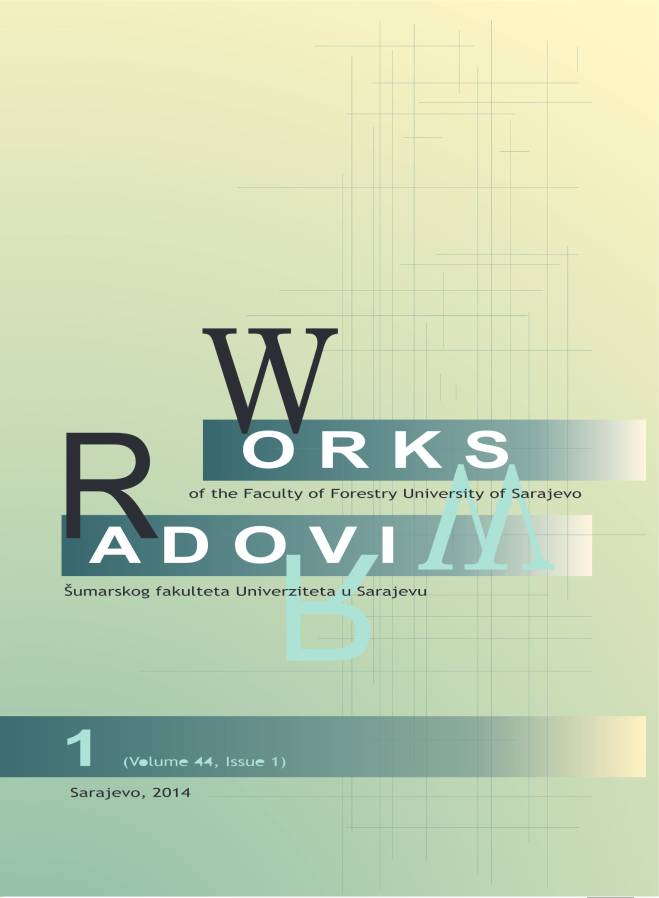ESTIMATION OF WOOD PRODUCTION SPATIAL DISTRIBUTION IN THE HIGH FOREST ON IGMAN MOUNTAIN
DOI:
https://doi.org/10.54652/rsf.2014.v44.i1.104Keywords:
wood volume and increment, inventory control sample, Landsat TM, k-NN estimates, spatial mappingAbstract
UDK: 630*52/*56:528.8(234.422 Igman)
Information about quantitative and qualitative forest attributes are the base for successful forest planning and management. Forest inventories collect number of data used for different estimations from large (management unit level) to small (forest stand) scales. Then, control sampling has to be done in order to confirm regularity of terrestrial work. Such sample becomes data source too. Recent approach for forest characterization includes all available information as sources for additional non-standard insight. Here were used available data about wood volume and increment from control sample for high forest on mountain Igman. Also, recent Landsat TM image from vegetation period was available and used in this research. Here is applied k nearest neighbor’s estimation method. Five nearest neighbors and Euclidian distance is chosen for estimation and mapping. Biases for all forest attributes were non-significant. Obtain results show non significant differences between means and observed and estimated distributions of wood volume and increment. It is estimated higher mean wood volume and increment of broadleaves while means for conifers and totals are lower. That higher wood volume and increment is estimated in all diameter classes for broadleaves while lower quantities are estimated for conifers. Spatial mapping presents distribution of wood volume and increment respecting variability of vegetation in high forest on Igman.
References
CHIRICI G., CORONA P., MARCHETTI M., MASTRONARDI A., MASELLI F., BOTTAI L., TRAVAGLINI D. (2012): K-NN FOREST. User's guide and tutorial. Available on-line at www.forestlab.net.
CHIRICI, G., A. BARBATI, P. CORONA, M. MARCHETTI, D. TRAVAGLINI, F. MASELLI, AND R. BERTINI. 2008. Non-parametric and parametric methods using satellite images for estimating growing stock volume in Alpine and Mediterranean forest ecosystems. Remote Sensing of Environment 112(5):2686-2700.
ČABARAVDIĆ A., PELZ R. D., CHIRICI G., KUTZER CH., ĆATIĆ E., DELIĆ H. (2011): Weighted functions in the k-NN estimates of growing stock in high forest in Bosnia. Works of Faculty Forestry University of Sarajevo. Vol 2. p. 15-29.
ČABARAVDIĆ A., TREŠTIĆ T., MUJEZINOVIĆ O. (2012): Procjena prostorne rasprostranjenosti oštećenja šuma na bazi daljinske detekcije. ANU BiH. Naučna konferencija ŠUME – INDIKATOR KVALITETA OKOLIŠA. Zbornik radova.
ČABARAVDIĆ A., LOJO A., BALIĆ B., OSMANOVIĆ M., AVDAGIĆ A., MAHMUTOVIĆ G. (2014): Procjena šumskih drvnih zaliha unsko-sanskog područja na bazi taksacionih snimanja druge nacionalne inventure šuma i IRS satelitskih snimaka/Growing stock estimation of productive forest in unsko-sansko area based on the 2nd national forest inventory field data and IRS satellite images. Naše šume/Our forests. No 32-33, str. 4-11.
ČABARAVDIĆ A. (2007): Efficient Estimation of Forest Attributes with k NN. Ph.D. thesis, Faculty of Forest and Environmental Sciences, Albert-Ludwigs-Universität Freiburg im Breisgau, Germany.
Forest management plan for the Forest management area "Igmansko".
FRANCO – LOPEZ, H., A. R. EK, AND M. E. BAUER. (2001): Estimation and mapping of forest stand density, volume and cover type using k-nearest neighbors method. Remote Sensing of Environment, 77: 251-274.
HAAPANEN, R., EK., R., A., BAUER, E., M., FINLE, O., A. (2004): Delineation of forest/nonforest land use classes using nearest neighbour methods. Remote Sens. Environ., 89: 265-271.
KATILA, M., TOMPPO, E. (2001): Selecting estimation parameters for the Finnish multisource National Forest Inventory. Remote Sensing of Environment, 76: 16-32.
LOJO., A. (2012): Metodika rada pri izradi šumskogospodarskih osnova za Šumsko gospodarska područja u Kantonu Sarajevo. Izvještaj projekta.
MAHMUTOVIĆ G., ČABARAVDIĆ A., OSMANOVIĆ M. (2013): Procjena drvnih zaliha na bazi Landsat TM+ snimka na šumovitom miniranom području GJ Majevica – Jablanička rijeka/Growing stock estimation based on the Landsat TM+ on forested mined area of Majevica – Jablanička rijeka. Naše šume/Our forest. No 30-31, XII godina, str. 13-20.
MCROBERTS, R., NELSON, M. D., WENDT, D. G. (2002): Stratified Estimation of forest Area using Satellite imagery, Inventory Data and the k-nearest neighbors technique. Remote Sensing of Environment, 82: 457-468.
TOMPPO, E., HALME, M. (2004): Using coarse scale forest variables as ancillary information and weighting of variables in k-NN estimation: a genetic algorithm approach. Remote Sensing of Environment 92.


















